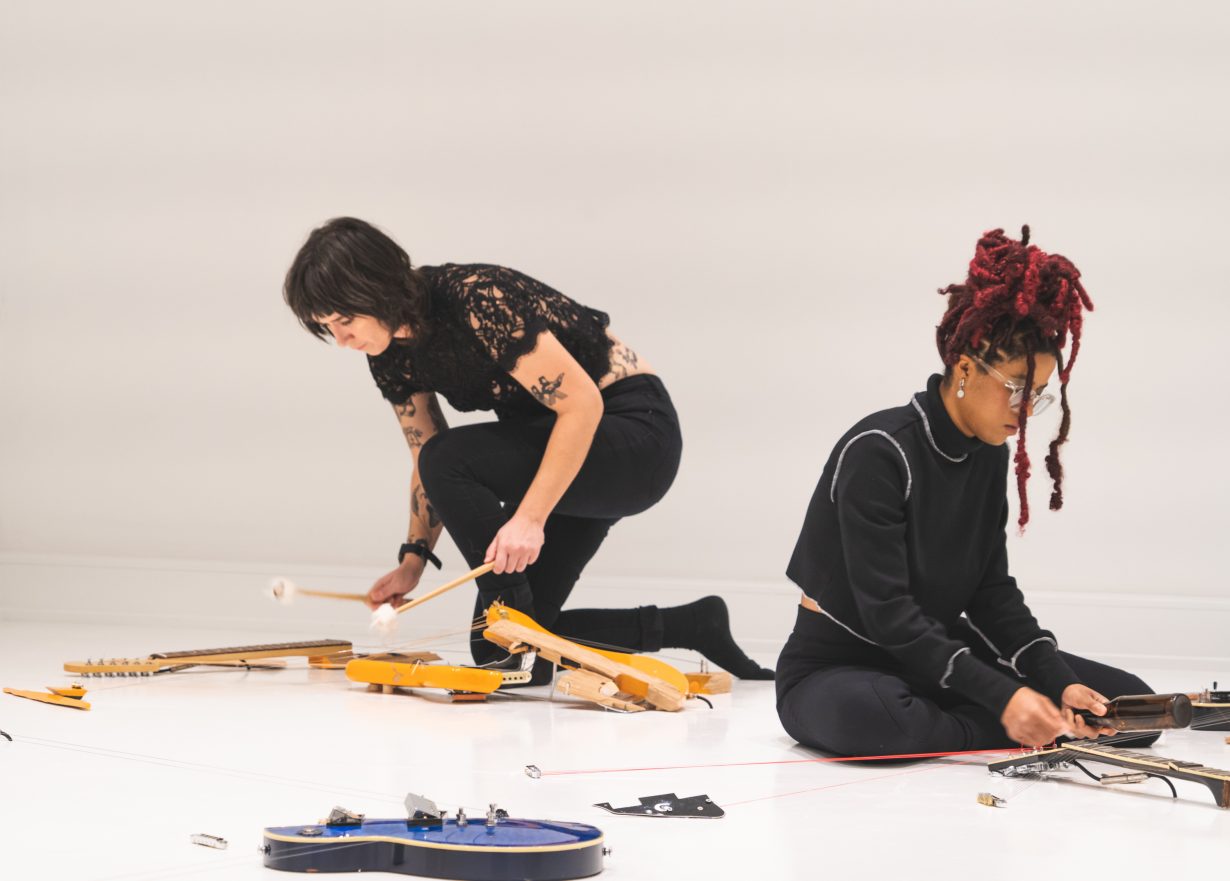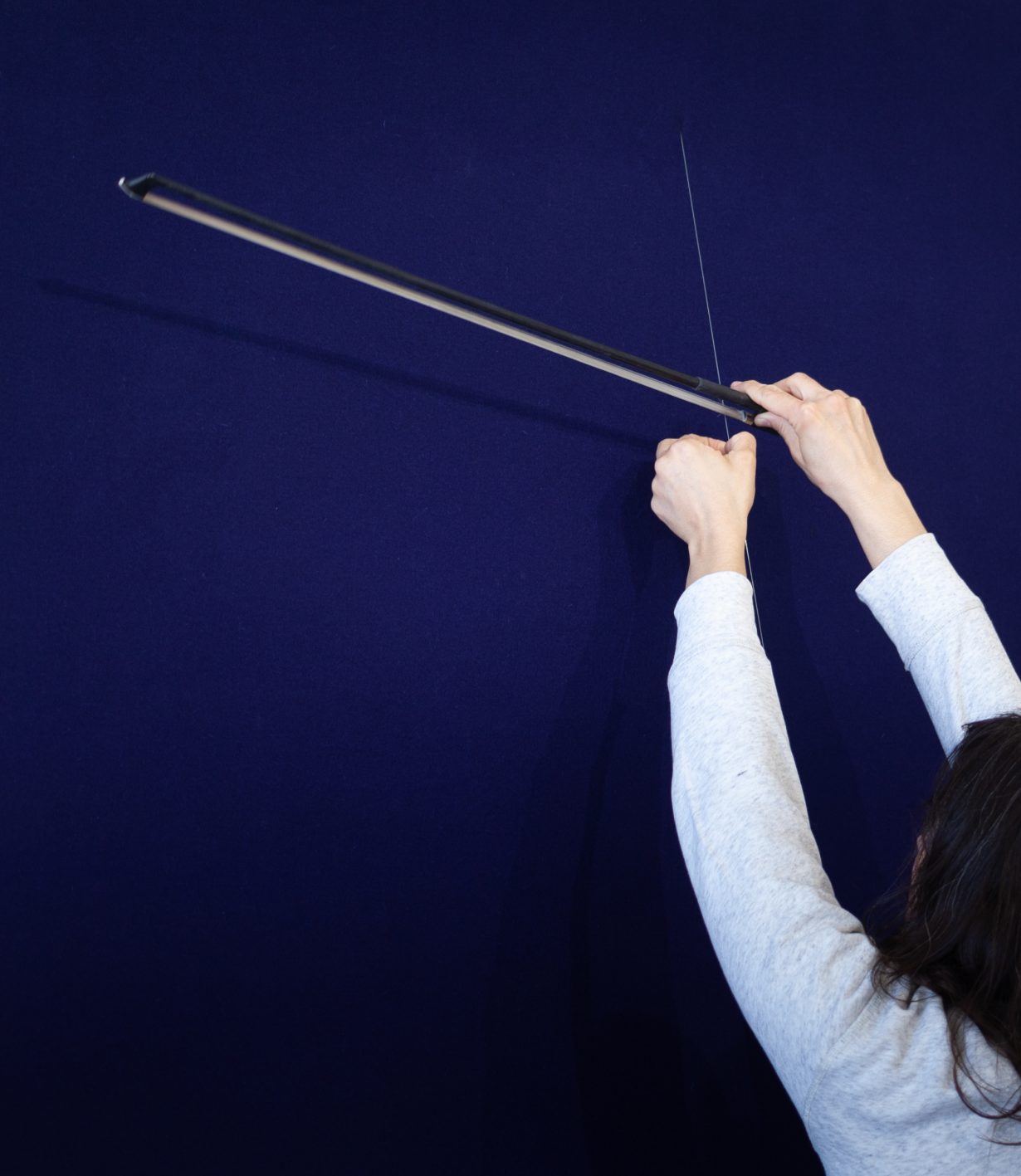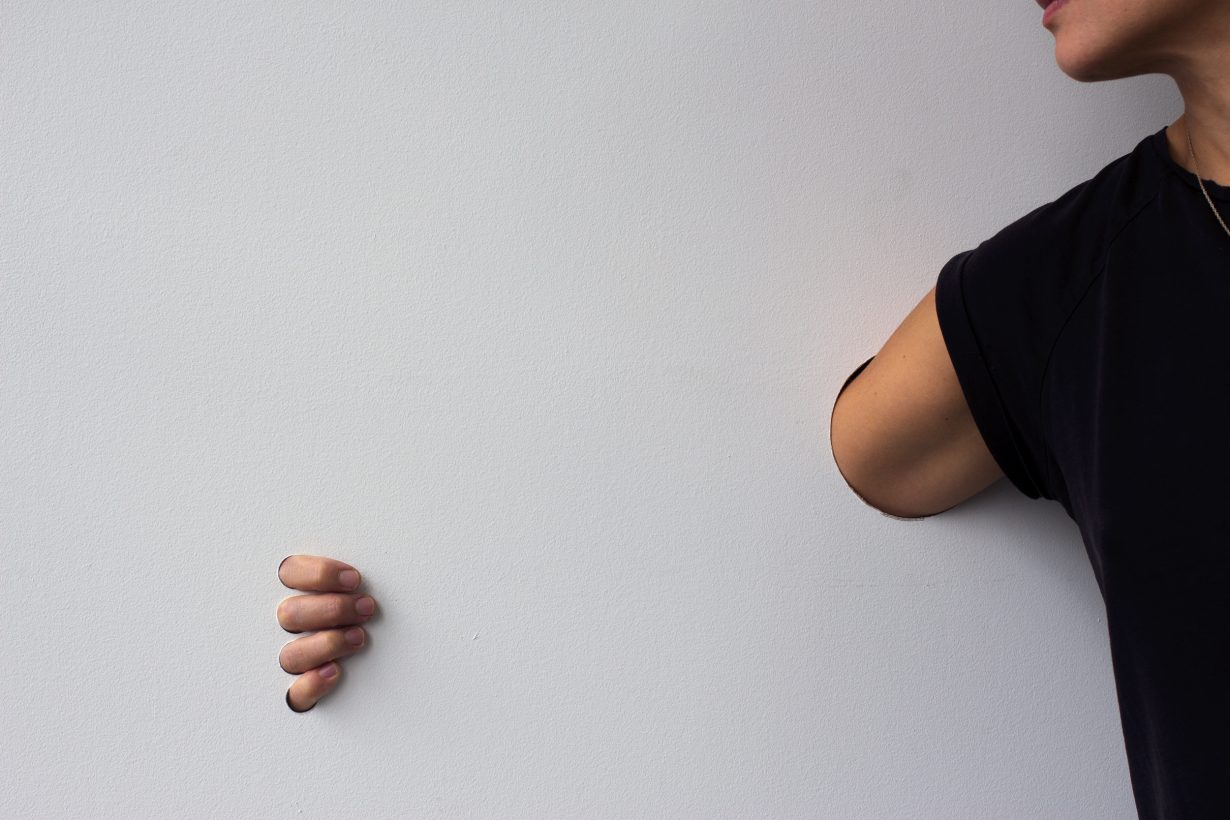Tsabar’s ‘deviant’ musical instruments invite chance and collaboration into the hallowed spaces of art
Often repurposing parts of existing instruments, Naama Tsabar builds new ones: sculptures and architectural interventions, sized to her body, that act as experimental vectors for sound and performance. Presented in shows just as likely to generate an LP as an exhibition catalogue (Perimeters, her 2021 exhibit at Miami Beach’s Bass Museum, yielded a hybrid vinyl-catalogue), these works oscillate between object and event as they are activated by gallerygoers, the artist and her collaborators.
When I visit Tsabar at her Brooklyn studio, the Tel Aviv-born artist is reconfiguring arrangements of deconstructed violin and viola bows that hang from nails in the drywall – the beginnings of a new project, she tells me. Moving with the dexterity of a lawless archetier, she sketches in space, exploring different visual compositions as she repositions the bows on the nails or adjusts the sliding mechanisms that tighten and slacken the hair. “I’ve been looking for bows where the horsehair is synthetic or sourced humanely, rather than being a byproduct of butchering,” she says as she experiments. “The violence inherent to the tools that we use to make music really makes you think about classical music in a different way.”
In her work, Tsabar, whose first institutional solo exhibition in Germany opens at Hamburger Bahnhof in Berlin this March, eschews or subverts various violences in music. The artist, who got her start in a punk band, is attuned to the historical marginalisation of women musicians in genres like punk and rock, the devaluation of ancillary or supportive labour in the industry at large and an endemic emphasis on mastery and hierarchy at the expense of experimentation and collaboration. Her art imagines otherwise.
Tsabar’s handsome performance objects, which often feature readily activatable musical strings, demand to be played with, to be touched. They encourage a generative mode of sensory engagement that art institutions are wont to proscribe due to some combination of concern about archival (or financial) damage and an industry-wide opticalcentrism. Scholars Constance Classen and David Howes have described how the rise of the public art museum in the nineteenth century engendered new etiquette prohibiting touch, geared towards working-class visitors; this dovetailed with Western frameworks that deemed touch an ‘uncivilised’ sense and elevated sight for its connections to scientific ideology and capitalist display. Tsabar is among the artists today – many of whom are interested in challenging sensory or social hierarchies – whose work questions this dogma.

The first piece by Tsabar that I ever touched – while touring a private collection several years ago, followed by encounters at Kasmin in New York and Shulamit Nazarian in Los Angeles – hailed from her ongoing Melodies of Certain Damage series (2018–), the least abstract of the five bodies of work that will be on view in Berlin. The artist smashes an electric guitar in her studio and allows the fallen pieces to form a map; then, she screws the fragments to the floor or a platform and restrings the instrument accordingly. Tsabar’s use of chance operations to guide her decision-making chimes with the legacy of avant-garde musician John Cage, who famously composed music using the I Ching during the 1950s.
Guitar-smashing, the orgasmic crescendo of concerts, has become a shorthand for rockstar machismo, but it also has roots in avant-garde thinking about artmaking in a destructive society. Tsabar engages with both legacies, subverting the first as she draws out the second. The Who’s Pete Townshend, who in 1964 became the first rock musician to break a guitar onstage, was inspired by artist Gustav Metzger’s notion of ‘auto-destructive art’, coined in 1959 to describe public art that contained the seeds of its own destruction to attack the ‘capitalist values and the drive to nuclear annihilation’. In 1966 Metzger convened the Destruction in Art Symposium in London, at which Raphael Montañez Ortiz, an artist-activist interested in destruction’s healing and decolonial potential, decimated a piano used by composer Fran Landesman and recorded the accompanying sounds. Also in attendance was Fluxus artist and classically trained musician Nam June Paik, who in 1962 smashed a violin onstage: an irreverent mode of playing the instrument that broke with musical convention as it foregrounded the instrument’s frangibility, and thus music’s objecthood.
When gallerygoers encounter the Melodies, the destructive act has already occurred. Instead of witnessing the break, we inhabit the brokenness, striving to make new sounds, languages and systems out of what arrived in pieces. To play these erstwhile guitars, viewer-participants assume intimate and vulnerable postures, kneeling, squatting or even lying down as they meet the constellated constructions with their bodies; most pluck the strings with their fingers, though some performers have also used guitar picks, percussion mallets and bottles. Like Tsabar’s other deviant instruments, the Melodies invite necessarily amateur, intuitive and ‘failed’ modes of music-making (and, for that matter, exhibition-going). The intrinsic value ascribed to such experiences by her practice chimes with Jack Halberstam’s assertion, in The Queer Art of Failure (2011), that ‘under certain circumstances failing, losing, forgetting, unmaking, undoing, unbecoming, not knowing may in fact offer more creative, more cooperative, more surprising ways of being in the world’.

“You don’t have to be ‘good’ at your instrument in order to play it and form something with other people,” Tsabar remarks. At Hamburger Bahnhof, as with previous exhibitions, she will organise a temporary band with her longtime collaborators (vocalist Lindsay Powell and drummer-architect Sarah Strauss) and local musicians and dancers, all of whom are women and non-binary. Historical precedent for avant-garde musical improvisation by a shifting pool of feminist and queer women, not all of whom are trained musicians, was set by the marvellously outré Feminist Improvising Group (1977–82), which incorporated feminist consciousness-raising into their workshops. In Tsabar’s framework, participants meet for workshops where they improvise with the show’s instruments; once they have articulated a shared vocabulary, they collaboratively write and ritualistically perform a composition that vacillates between textured atonality and swells of harmony. “It’s magic,” says Tsabar of the process. The performances continue after she has departed; her hope is that the communities they catalyse do, too.
The inaugural performance will activate every work in the show – pieces on the floor and walls, and embedded within the gallery’s architecture – so the whole space throbs with sound, like a cathedral with the organ piping. To make the Inversions (2020–), Tsabar cuts holes directly into the museum’s walls. The gesture conjures up Gordon Matta-Clark’s ‘building cuts’ of the 1970s, in which the artist sliced open structures doomed to demolition to create sculptures and critique the social conditions underlying the buildings’ decrepitude; Tsabar’s ‘cuts’ might be seen as critiquing museological drives towards stasis and containment. But these seductive cavities, whose triangular, semicircular and lozengelike shapes are informed by her research into the evolution of sound holes, feel more akin to confessionals in their summons to intimacy and function as sonic chambers.

Their interiors, which are lined with the red maple used in violins, are fitted with hidden microphones so they can be activated with song and speech, or alternatively, equipped with guitar, bass and piano strings or motion sensors so they can be activated by touch or movement. For the latter Inversions, gallerygoers can move hands or other body parts (Tsabar has used her head) within the cavity to blend ethereal sound files featuring women vocalists Rose Blanshei and Wolf Weston as well as Brood X Cicadas (the males buzz, while the females click). These periodical cicadas, which Tsabar recorded in 2021, spend 17 years underground before surfacing en masse; the artist is interested in the little singers’ collective rhythms, as well as the strategic concealment that enables them to thrive. Beauty, she suggests, is one such strategy. “In Western society, it has historically been something of an anomaly to hear women’s voices in public spaces,” says Tsabar. “But under the veil of melody, which I associate with structure and beauty, their voices could sound.”
One of the longest-running series in the show, the Work on Felt (2012–) pieces deploy their own forms of concealment as well as tactical pseudomorphism. Hung on the wall or laid on the floor, they are made of large expanses of industrial felt that have been slit or layered and affixed with strings. While they reference Robert Morris’s cut felt sculptures of the late 1960s, which yoked Minimalism’s focus on materiality to an interest in the body, Tsabar’s Felts contain hidden carbon fibre that, in concert with the piano strings, enables them to be played via plucking and pulling, the latter of which modulates pitch by making the work more curved or flat. As this move presumably takes a swipe at the male-dominated art-historical canon, it also helps usher Tsabar’s sonic social-practice project into all manner of art spaces. That isn’t to say that the visual is immaterial to her work; to the contrary, visual composition frequently informs and precedes sound, as with the Felts, which grow out of paper maquettes.
Not all of the works in the Berlin exhibition are playable. Twilight (Gaffer Wall) (2006–) is a museum wall sheathed in the black tape used to inconspicuously hold cables in place onstage. As a monument to the invisible and frequently collective labour integral to many forms of creative production, the swathed support structure prompts rumination on the various concrete ways in which artists and art institutions might endeavour to make such labour visible, such as Josh Kline’s practice of listing his fabricators, and what benefits such visibility confers. The final suite of works in the show, Metronomes (2018–), is likewise unactivatable, comprising pairs of sneakers whose soles, gradually sculpted by wear, are embedded with metronomes timed to a human heartbeat. Titled after the period during which Tsabar wore them (for example, September 1 2018 – January 15 2021[2018–21]), these shoes-turned-kinetic-sculptures allude to the time based medium of a human body that trudges, labours, performs, lives and dies. They paint a picture of an artist almost never off the clock, but equally, one for whom art is necessarily in every step.
A solo show of Naama Tsabar’s work can be seen at Hamburger Bahnhof, Berlin, through 22 September

